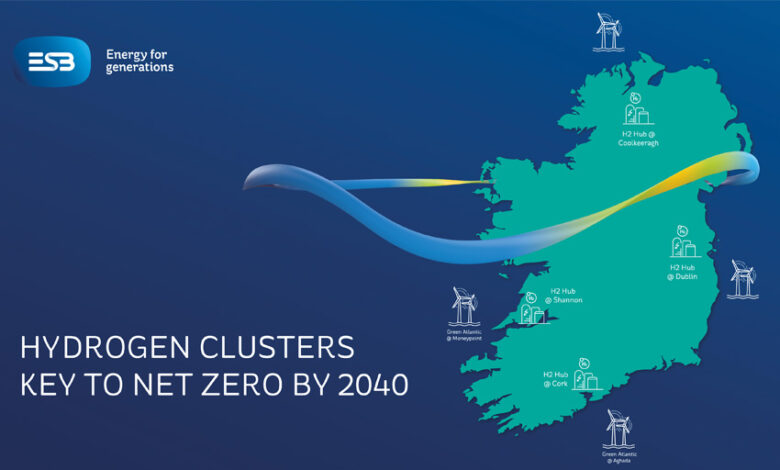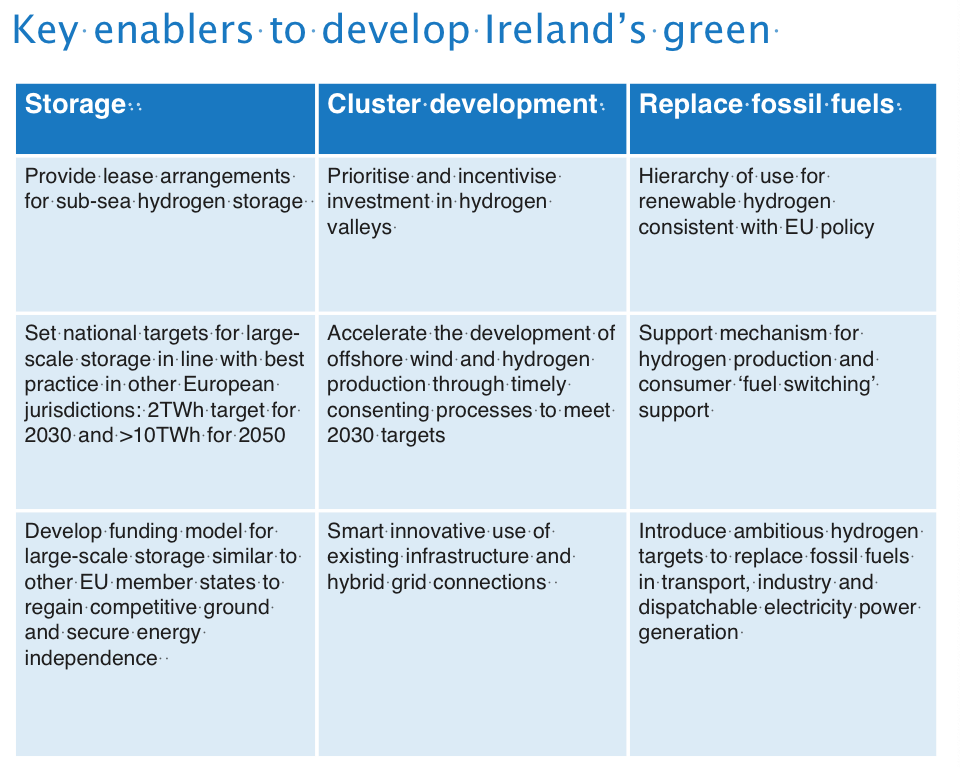Delivering net zero with hydrogen: The key to an integrated and secure energy system

ESB is investing in Ireland with more than €1 billion spent every year towards our goal of delivering a zero-carbon energy future. Hydrogen will feature prominently in these future investment plans. Aodhán McAleer, Hydrogen Manager at ESB, discusses the rationale behind the role of renewable hydrogen in the transition to net zero.
delivering a zero-carbon energy future. Hydrogen will feature prominently in these future investment plans. Aodhán McAleer, Hydrogen Manager at ESB, discusses the rationale behind the role of renewable hydrogen in the transition to net zero.
The role of hydrogen
Over the past couple of years, policy discussions on renewable hydrogen have evolved beyond just its ability to decarbonise the energy system but also to its vital role in security of energy supply. The evolving geopolitical landscape has highlighted the need to focus on energy security, with increased urgency to develop a resilient energy system. EU legislators turned their attention to bolstering Europe’s energy resilience, to provide a policy pathway to energy independence through green hydrogen production and sufficient energy storage capacity. Now, more than ever, we must continue our focus on climate action through homegrown clean electricity to improve energy independence and improving long-term resilience and affordability. An unwavering focus is required to increase Ireland’s renewables, drive the production of green hydrogen, and develop storage capacity for the country’s hydrogen in order to meet climate and security of supply objectives.
Harnessing Ireland’s renewable potential
ESB is playing a key role in the delivery of Ireland’s climate objectives across the energy sector and has committed to achieving net zero by 2040. At national level, there is a legally binding target to achieve net zero emissions by 2050, and an interim target to reduce carbon emissions by 51 per cent by 2030 from a 2018 baseline.
The energy from Ireland’s abundant onshore and offshore wind resources can be converted into renewable green hydrogen using an established technology, electrolysis, to provide clean, reliable, and storable energy. Over the next decade, developing and scaling our hydrogen economy will require significant levels of investment. The forthcoming national hydrogen strategy will set out the Government’s vision for the 2GW of offshore wind earmarked for green hydrogen production. This provides a unique opportunity to decarbonise the energy consumption of large-scale energy users currently using fossil fuels, with the potential to scale and attract new low carbon industries around the coast of Ireland.
The first step in achieving this will be to harness Ireland’s renewables. While early green hydrogen projects will use existing onshore renewables, our significant homegrown offshore wind resources will enable Ireland’s green hydrogen sector to grow at scale. We have the resources to match our ambition. As noted in the Climate Action Plan, this requires dialling up to 9GW onshore wind, 8GW solar and at least 7GW of offshore wind by 2030 – with 2GW earmarked for green hydrogen production.
Our analysis shows that an integrated net zero energy system will require >30GW of offshore wind, hydrogen production capability >15GW, subsea hydrogen storage of circa 90 days, and backup dispatchable zero-carbon power generation >10GW.
There is broad agreement across industry that project attrition along the development pathway, particularly in relation to planning consents, is inevitable. Plans must provide a sufficient level of contingency to give confidence that the initial 5GW target by 2030 will be achieved from an offshore wind perspective, this means procuring more than 5GW from the first two offshore RESS auctions to allow contingency for delays and project attrition. We should accelerate the development of floating offshore wind (FLOW) to capture the full potential of the Celtic Sea and Atlantic Ocean beyond 2030, regain the competitive ground we have lost to other countries pushing ahead with developing local FLOW supply chains, and demonstrate Ireland’s willingness to play its part in the REPowerEU plan. FLOW technology is proven in other jurisdictions. The Scotwind leasing round has shown both the appetite for FLOW, with 17.8GW of FLOW projects awarded leases, and the confidence of the major developers. A strong offshore wind sector at scale is a prerequisite for driving a green hydrogen economy of scale. We believe a green hydrogen economy is essential to deliver Ireland’s net zero future.
In order to enable the timely delivery of projects, we should leverage existing infrastructure where possible to bring this energy ashore. One obvious way to do this is to use hybrid grid connections, which allows new renewable generation to link into existing grid connections. Two or more forms of generation could share a single connection to the grid and because their combined output would not exceed the existing connection capacity at any one time, no capacity upgrades would be required.

Hydrogen economy
The significant step in building the hydrogen economy is to incentivise the production of renewable hydrogen. Hydrogen producers need a line of sight to customers who want to use their product, this can be achieved by signalling much stronger ambition around the decarbonisation of the transport or heavy industry sectors that are not easily electrified but could switch to using zero carbon hydrogen and by incentivising zero carbon dispatchable electricity generation where methane gas is replaced with zero carbon hydrogen. Aside from the environmental benefits associated with developing zero carbon dispatchable energy, it will enhance security of supply when meteorological conditions mean wind and solar resources are not enough to meet demand. Financial supports will also be necessary to lure energy users away from lower-cost, readily available fossil fuels.
The final building block for the hydrogen economy relates to large-scale energy storage. Primary energy security is currently provided by storage reserves of oil and coal, and by gas interconnection with Britain. These fossil fuels provide baseload energy and most of the flexibility to balance supply and demand on the system. In a zero-carbon system based on high levels of wind, there will be times of imbalance on the system as both demand and supply fluctuate. Alternatives to fossil fuels are needed that offer cheap, large capacity and long duration storage options, and which provide flexibility and balancing solutions.
Subsea geological storage of green hydrogen can provide this through large-scale seasonal storage of renewable energy. Due to the long lead times involved in developing subsea hydrogen storage, effective market solutions are needed urgently to provide investors with a clear route to market. ESB is currently partnering with dCarbonX/Snam on the development of renewable hydrogen subsurface storage as part of hydrogen valleys and clusters in the east (Dublin), south (Cork) and west (Shannon Estuary).
This concept of hydrogen valleys and clusters, currently being promoted by the EU, where all the elements of renewable hydrogen production, storage, and end-use are in an integrated ecosystem is an efficient cost-effective approach that supports balanced regional economic development and should be incentivised. They are key to kickstarting and rapidly scaling hydrogen supply and demand, especially around industrial clusters where hydrogen infrastructure could be shared amongst multiple users in proximity, including zero carbon dispatchable power generation. By locating these clusters on coastal sites, port infrastructure can be leveraged to enable export of hydrogen and, hence, achieve a scale to lower the cost of green hydrogen.
Net zero energy system
Renewable hydrogen coupled with offshore wind is a compelling proposition to accelerate decarbonisation as part of the larger integrated zero-carbon energy system. As part of our strategic vision, ESB is invested in the delivery of net zero and playing our part in the foundation of the four large infrastructure elements required, namely renewables, hydrogen, storage, and zero-carbon dispatchable power generation, to deliver a secure, resilient, reliable net-zero integrated energy system for generations to come.
W: www.esb.ie/esb-and-renewable-energy






